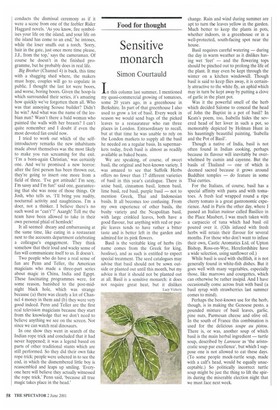Food for thought
Sensitive monarch
Simon Courtauld
In this column last summer, I mentioned my quasi-commercial growing of tomatoes, some 20 years ago, in a greenhouse in Berkshire. In part of that greenhouse I also used to grow a lot of basil. Every week in season we would send bags of the picked leaves to a restaurateur who ran three places in London. Extraordinary to recall, but at that time he was unable to rely on the London markets to supply all the basil he needed on a regular basis. In supermarkets today, fresh basil is almost as readily available as baked beans.
We are speaking, of course, of sweet basil, the original and best-known variety. I was amazed to see that Suffolk Herbs offers no fewer than 17 different varieties of basil in this year's catalogue. There is anise basil, cinnamon basil, lemon basil, lime basil, red basil, purple basil — not to mention Greek, Thai and Indonesian basils. It all becomes too confusing. From my own experience of other basils, the bushy variety and the Neapolitan basil, with large crinkled leaves, both have a good flavour, but anything with red or purple leaves tends to have rather a bitter taste and is better left in the garden and admired for its pink flowers.
Basil is the veritable king of herbs (its name comes from the Greek for king, basileus), and as such is entitled to expect special treatment. The seed catalogues may advise that basil should not be sown outside or planted out until this month, but my advice is that it should not be planted out at all. Basil is a sensitive monarch: it does not require great heat, but it dislikes
change. Rain and wind during summer are apt to turn the leaves yellow in the garden. Much better to keep the plants in pots, whether indoors, in a greenhouse or in a well-protected, south-facing spot near the house.
Basil requires careful watering — during the day in warm weather as it dislikes having wet 'feet' — and the flowering tops should be pinched out to prolong the life of the plant. It may even be kept through the winter on a kitchen windowsill. Though basil is said to keep flies away, it is certainly attractive to the white fly, an aphid which may in turn be kept away by putting a clove of garlic in the plant pot.
Was it the powerful smell of the herb which decided Salome to conceal the head of John the Baptist in a pot of basil? In Keats's poem, too, Isabella hides the severed head of her lover in such a pot, so memorably depicted by Holman Hunt in his hauntingly beautiful painting, 'Isabella and the Pot of Basil'.
Though a native of India, basil is not often found in Indian cooking, perhaps because its flavour will inevitably be overwhelmed by cumin and cayenne. But the basils of Thailand — one of which is deemed sacred because it grows around Buddhist temples — do feature in some Thai curries.
For the Italians, of course, basil has a special affinity with pasta and with tomatoes. A fresh leaf wrapped round a ripe cherry tomato is a great gastronomic experience. And in Paris the other day, where I passed an Italian traiteur called Basilic° in the Place Maubert, I was much taken with a carpaccio of tuna which had basil oil poured over it. (Oils infused with fresh herbs will retain their flavour for several months. For those who don't want to infuse their own, Castle Aromatics Ltd, of Upton Bishop, Ross-on-Wye, Herefordshire have a wide selection, using sunflower oil.)
While basil is used with shellfish, it is not generally found in white-fish dishes. But it goes well with many vegetables, especially those, like marrows and courgettes, which can otherwise be rather insipid. And I have occasionally come across fruit with basil (a basil syrup with strawberries last summer comes to mind).
Perhaps the best-known use for the herb, though, is in making the Genoese pesto, a pounded mixture of basil leaves, garlic, pine nuts, Parmesan cheese and olive oil. In the south of France this combination is used for the delicious soupe au pistou. There is, or was, another soup of which basil is the main herbal ingredient — turtle soup, described by Larousse as 'the aristocratic soup par excellence', but which I suppose one is not allowed to eat these days. (To some people mock-turtle soup, made with a calf s head, would be equally unacceptable.) So politically incorrect turtle soup might be just the thing to lift the spirits during the miserable election night that we must face next week.










































































 Previous page
Previous page